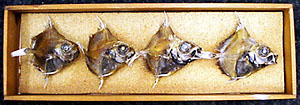
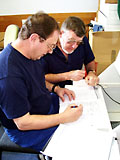
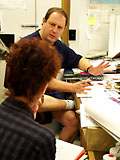 Once we reach Kaikoura and the actual research dives in the Deep
Rover begin, there will be many pairs of eyes glued to the video
monitors on board the Kaharoa. With at least four cameras on
Deep Rover, chances are there will be many things to watch.
Since this is the first time a submersible with Deep Rover's capabilities
will be visiting the depths of Kaikoura Canyon, there is a great
deal of anticipation as to what may appear on the video screens.
In order to quickly identify and count all the creatures that may
dart into view, a number of different identification log sheets are
being put together. Since it is difficult for any one person to be
able to identify all the possible animals that may swim into view,
Clyde got together with few people this morning to help design the
tally sheets that will be used.
Once we reach Kaikoura and the actual research dives in the Deep
Rover begin, there will be many pairs of eyes glued to the video
monitors on board the Kaharoa. With at least four cameras on
Deep Rover, chances are there will be many things to watch.
Since this is the first time a submersible with Deep Rover's capabilities
will be visiting the depths of Kaikoura Canyon, there is a great
deal of anticipation as to what may appear on the video screens.
In order to quickly identify and count all the creatures that may
dart into view, a number of different identification log sheets are
being put together. Since it is difficult for any one person to be
able to identify all the possible animals that may swim into view,
Clyde got together with few people this morning to help design the
tally sheets that will be used.
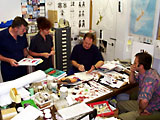 Along with Clyde were Mike Sweeney, a fellow cephalopod biologist from
the Smithsonian, Di Tracey, a NIWA specialist in deep water fishes and
fisheries and Steve O'Shea, who in addition to all his work with the giant
squid of late, is a specialist in octopods and is also very knowledgeable
about other invertebrates of this region. Besides just being a quick
identification guide, the tally sheet will also allow the observer to quickly
count whatever comes into view so that some measure of the biodiversity
of Kaikoura canyon can be made.
Along with Clyde were Mike Sweeney, a fellow cephalopod biologist from
the Smithsonian, Di Tracey, a NIWA specialist in deep water fishes and
fisheries and Steve O'Shea, who in addition to all his work with the giant
squid of late, is a specialist in octopods and is also very knowledgeable
about other invertebrates of this region. Besides just being a quick
identification guide, the tally sheet will also allow the observer to quickly
count whatever comes into view so that some measure of the biodiversity
of Kaikoura canyon can be made.
As I sat there listening to their discussions, most of which involved latin names of creatures that I hadn't the slightest idea of what they could possibly be, I looked around Steve's office which is filled from floor to ceiling with jars, vials and boxes containing creatures of every size, color and shape imaginable. Suddenly, there in a little box about two feet long, i saw a row of four little fish, each a couple of inches long, that looked remarkably familiar.

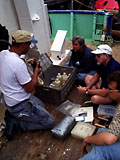 Early that afternoon, Clyde received a call saying that the second session of
Deep Rover training was going to begin and that we should make our way back to the
Kaharoa. Ian assembled his students, Clyde and Mike with myself as observer
on the fantail, and with great ceremony brought out a large gray plastic container.
This, Ian told them was their emergency kit, and it contained all the things that
must be placed inside the submersible each and every time the Deep Rover
enters the water, no matter how short the dive might be planned to last.
Emergencies can happen at any time and you have to be prepared.
Early that afternoon, Clyde received a call saying that the second session of
Deep Rover training was going to begin and that we should make our way back to the
Kaharoa. Ian assembled his students, Clyde and Mike with myself as observer
on the fantail, and with great ceremony brought out a large gray plastic container.
This, Ian told them was their emergency kit, and it contained all the things that
must be placed inside the submersible each and every time the Deep Rover
enters the water, no matter how short the dive might be planned to last.
Emergencies can happen at any time and you have to be prepared.
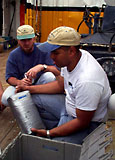
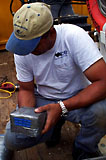 The variety of things contained in that box was amazing. Flashlights, water
bottles, oxygen test devices, first aid supplies and much more came out of that
box with Ian providing an complete explanation as to their use. Two packages were
completely wrapped in gray duct tape and were of particular interest. The one
that Ian referred to as "woolies" was a set of thermal underwear that
could be put on in case the pilot started to get cold. Although Deep Rover's five inch
acrylic sphere is a very good insulator, the aluminum ring that seals the
two halves together is not. The deep sea is a very cold and dark place and I
have to wonder just how warm a pair of woolen underwear is going to keep
you. In the meantime, the package of woolies serves the role of footrest
since it is usually placed just below the pilot's stocking feet.
I forget to
mention that shoes are not allowed at any time inside of Deep Rover. It would
be too easy to scratch the inside of the acryllic sphere with a pebble or nail that may
have gotten stuck to your shoe's sole. The other package, also sealed in the
same gray duct tape contained all the emergency food rations that are needed
to provide the complete nutritional requirements for one person for NINE
DAYS! This package, not much bigger than a large grapefruit apparently
contains some seriously nutrional material although in consistency it felt
more like playdough.
The variety of things contained in that box was amazing. Flashlights, water
bottles, oxygen test devices, first aid supplies and much more came out of that
box with Ian providing an complete explanation as to their use. Two packages were
completely wrapped in gray duct tape and were of particular interest. The one
that Ian referred to as "woolies" was a set of thermal underwear that
could be put on in case the pilot started to get cold. Although Deep Rover's five inch
acrylic sphere is a very good insulator, the aluminum ring that seals the
two halves together is not. The deep sea is a very cold and dark place and I
have to wonder just how warm a pair of woolen underwear is going to keep
you. In the meantime, the package of woolies serves the role of footrest
since it is usually placed just below the pilot's stocking feet.
I forget to
mention that shoes are not allowed at any time inside of Deep Rover. It would
be too easy to scratch the inside of the acryllic sphere with a pebble or nail that may
have gotten stuck to your shoe's sole. The other package, also sealed in the
same gray duct tape contained all the emergency food rations that are needed
to provide the complete nutritional requirements for one person for NINE
DAYS! This package, not much bigger than a large grapefruit apparently
contains some seriously nutrional material although in consistency it felt
more like playdough.
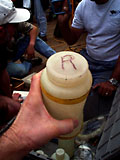 Fluid management in Deep Rover is pretty simple. You take some bottles of
water down with you each time you dive. In the event of an emergency, there
is a desalination device that can take salt water from a valve on the inside of
the sphere and extract about one liter of fresh water for every ten liters of
salt water that passes through it. In a serious emergency, the instructions
on the desalinator clearly suggest that it is possible to substitute urine in
place of sea water. There is a special plastic bottle with a large "R" written
across the top for just such a purpose.
Fluid management in Deep Rover is pretty simple. You take some bottles of
water down with you each time you dive. In the event of an emergency, there
is a desalination device that can take salt water from a valve on the inside of
the sphere and extract about one liter of fresh water for every ten liters of
salt water that passes through it. In a serious emergency, the instructions
on the desalinator clearly suggest that it is possible to substitute urine in
place of sea water. There is a special plastic bottle with a large "R" written
across the top for just such a purpose.
In addition to oxygen needing to be continuously added to keep the pilot alive,
it is equally important to remove the carbon dioxide (CO2) that the pilot
respires.
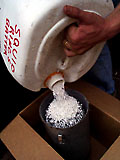 Since there is no way to selectively vent the CO2 to the
outside, the Deep Rover is equipped with two CO2 scrubbers that are metal
cannisters about six inches in diameter and about 12 inches in length
that are mounted inside on either side of the sphere. Fans continuously pass
air through the canisters where, by a fairly simple chemical reaction,
the excess CO2 is removed. Before each dive, the canisters must be refilled
with the chemical that does this job. This is done by taking the cannisters
out of the submersible, opening up one end and pouring what can best be
described as something that looks just like kitty litter inside. This "sodasorb"
comes in large plastic containers that someone specially labelled
for this expedition.
Since there is no way to selectively vent the CO2 to the
outside, the Deep Rover is equipped with two CO2 scrubbers that are metal
cannisters about six inches in diameter and about 12 inches in length
that are mounted inside on either side of the sphere. Fans continuously pass
air through the canisters where, by a fairly simple chemical reaction,
the excess CO2 is removed. Before each dive, the canisters must be refilled
with the chemical that does this job. This is done by taking the cannisters
out of the submersible, opening up one end and pouring what can best be
described as something that looks just like kitty litter inside. This "sodasorb"
comes in large plastic containers that someone specially labelled
for this expedition.
After this training session was completed, it was finally time to put Deep
Rover into the water for the first time. This test dive was going to be done
while still tied to the wharf and was primarily to check out the
submersible after its long journey to New Zealand to make certain that
all systems were still working as expected. Scott, one of the three
Deep Rover support crew was going to make the first "dive". In all
truth, it was going to be more of a first "dunk" since the Deep Rover
was still going to be attached to the ship's winch cable and it was not
going to dive below the surface.
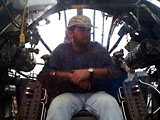
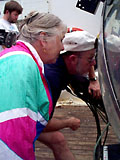 Nevertheless, it was treated as
a regular dive which meant that all the external and internal pre-dive
checklists and procedures had to be followed and those emergency supplies
needed to be tucked away wherever space could be found inside the
sphere. Ingrid and Clyde pressed their noses up to the sphere to watch
carefully as Scott went through all the pre-dive checks. Clyde in
particular had a vested interest in making sure he followed along with
each and every step since if all went well, he would soon be in the
pilot's seat himself.
Nevertheless, it was treated as
a regular dive which meant that all the external and internal pre-dive
checklists and procedures had to be followed and those emergency supplies
needed to be tucked away wherever space could be found inside the
sphere. Ingrid and Clyde pressed their noses up to the sphere to watch
carefully as Scott went through all the pre-dive checks. Clyde in
particular had a vested interest in making sure he followed along with
each and every step since if all went well, he would soon be in the
pilot's seat himself.
All systems checked out as expected and with the go-ahead given, Ian climbed on top of the aft support structure and attached the large, yellow metal clip to the Deep Rover's hoisting strap. The winches groaned and with great care, Deep Rover lifted off the deck of the Kaharoa for the very first time with a pilot on board. Once the Deep Rover was high enough to clear the stern rail, the large A-frame gantry was tilted back and the sub passed over the stern and was ready to be lowered. Two lines were attached to each side of the Rover to keep it from swinging during this process.
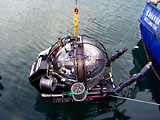
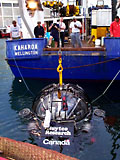 As Ian kept his eye on Deep Rover, he pointed his index finger towards the
deck and traced out small circles with it. This was his signal to the winch operator
to let out cable and lower the sub. Just as the Deep Rover's sphere started to
touch the waters of Wellington Harbor for the very first time, Ian clenched his
hands into a fist to signal the winch to stop. Scott pulled out a little mirror that
was alongside him in the pilot's seat and held it underneath his feet to see
whether of not there were any leaks.
As Ian kept his eye on Deep Rover, he pointed his index finger towards the
deck and traced out small circles with it. This was his signal to the winch operator
to let out cable and lower the sub. Just as the Deep Rover's sphere started to
touch the waters of Wellington Harbor for the very first time, Ian clenched his
hands into a fist to signal the winch to stop. Scott pulled out a little mirror that
was alongside him in the pilot's seat and held it underneath his feet to see
whether of not there were any leaks.
Seeing none, he signaled to Ian via the two-way radio that the dive could
continue. The winch started again and this time the sub was lowered until
the sphere was submerged just about halfway. Scott repeated the check for leaks and
again finding none, told Ian that it was fine to lower all the way.
When ballasted for the surface, Deep Rover floats with just a few inches of
the top of the sphere above the surface.
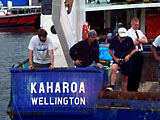 For about thirty minutes or so, Scott bobbed around at the end of the winch cable
performing a series of system and electrical checks while the rest of the crew
watched with great interest from the stern of the Kaharoa. In particular, Clyde
and Mike deGruy seemed to be paying particularly close attention to everything
that was happening . Finally, with all the checks being completed and with just
a few minor electrical problems being found, the Deep Rover was hoisted back on deck,
the sphere opened up and Scott emerged. The Deep Rover's crew quickly started to
deal with the few issues that came up during this test and after a couple of
hours the word came down that they were ready to "dive Mike".
For about thirty minutes or so, Scott bobbed around at the end of the winch cable
performing a series of system and electrical checks while the rest of the crew
watched with great interest from the stern of the Kaharoa. In particular, Clyde
and Mike deGruy seemed to be paying particularly close attention to everything
that was happening . Finally, with all the checks being completed and with just
a few minor electrical problems being found, the Deep Rover was hoisted back on deck,
the sphere opened up and Scott emerged. The Deep Rover's crew quickly started to
deal with the few issues that came up during this test and after a couple of
hours the word came down that they were ready to "dive Mike".
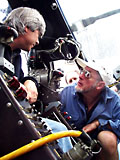
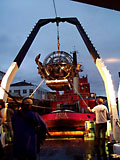 As before, the complete pre-dive series of external and internal checks were done,
crossing off each item on the checklist as it was completed.
Mike deGruy and
Clyde had a few last minute words before the Deep Rover was sealed, the lift
cable attached and the dive got underway. By this time, the sun had started to set
and the skipper had turned on the lights that were attached to the A-frame.
As the Deep Rover was lifted off the deck, bathed in the warm glow of these
lights, we could all see Mike getting familiar with his new surroundings.
The A-frame tilted aft, the cable let down and the Deep Rover was once again
in the water. Mike did another series of tests including using the Deep Rover's
propulsion thrusters. Since he was so close to the surface, these created quite the
stir, churning the waters around the sub into a frothy mass.
As before, the complete pre-dive series of external and internal checks were done,
crossing off each item on the checklist as it was completed.
Mike deGruy and
Clyde had a few last minute words before the Deep Rover was sealed, the lift
cable attached and the dive got underway. By this time, the sun had started to set
and the skipper had turned on the lights that were attached to the A-frame.
As the Deep Rover was lifted off the deck, bathed in the warm glow of these
lights, we could all see Mike getting familiar with his new surroundings.
The A-frame tilted aft, the cable let down and the Deep Rover was once again
in the water. Mike did another series of tests including using the Deep Rover's
propulsion thrusters. Since he was so close to the surface, these created quite the
stir, churning the waters around the sub into a frothy mass.
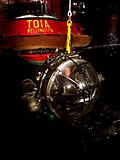 All too soon (from Mike's perspective I'm sure) it was time to bring Deep
Rover back on board. As the sub broke through the surface, the brightness
of the lights was only matched by the sparkle in Mike's eyes and the smile
on his face.
All too soon (from Mike's perspective I'm sure) it was time to bring Deep
Rover back on board. As the sub broke through the surface, the brightness
of the lights was only matched by the sparkle in Mike's eyes and the smile
on his face.
best regards,
gene